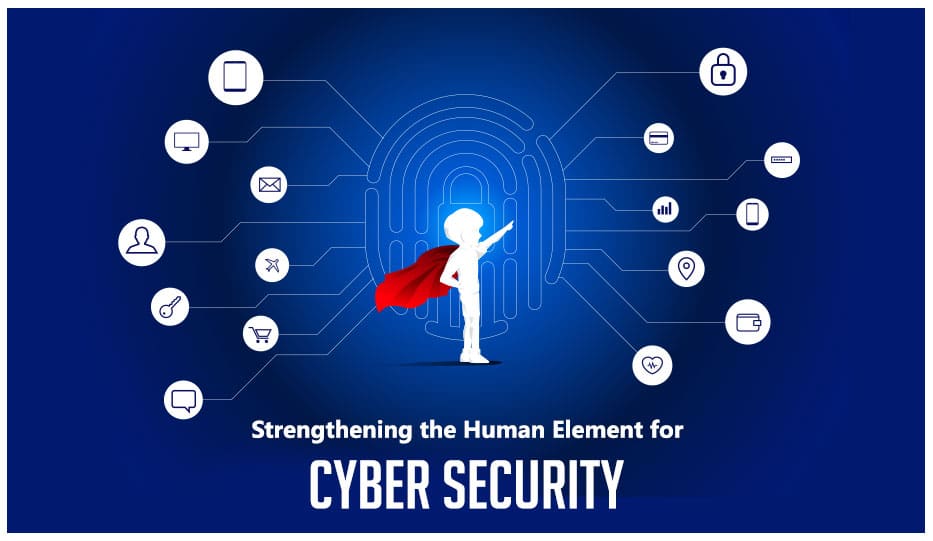
Businesses tend to be a bit apprehensive about proper cybersecurity training for their employees because they feel it distracts them from building their core competencies. Naturally, no business wants its employees to divert themselves from the actual work to worry about cyber practices around the workplace. However, considering the several types of social engineering attacks, it is evident that negligent employees and other associated people are sometimes the weakest links in the cybersecurity posture of an organization. In this blog, therefore, we are going to discuss how you can strengthen the human element for better cybersecurity.
The Strategy for Making the Human Element Stronger
Today we are discussing a 3-phase strategy for making sure your employees, partners, and security teams do not falter on cybersecurity.
The first step in strengthening the human element is to enhance the capabilities of these involved entities so that they are better equipped to deal with the cybersecurity scenario.
The second step is to automate your organizations process to detect and mitigate prevalent cyber threats.
The last step is to outsource some unavoidable aspects of your cybersecurity to professionals who will be dedicated to bettering your cybersecurity.
Enhance
Employees
Cyber attacks become successful for one of two reasons: either a technology failed (zero-day attacks for e.g.) or a human being made fatal errors (for example phishing campaigns). However, the best way to prevent successful cyber-attacks against your organization is to stop the attacks as early as possible to avoid spending tons of time and resources to mitigate the after-effects.
And often, the first line of defence against cyber threats are the employees who are easier targets for hackers than jailbreaking secure applications.
Therefore, you need to enhance the involved human entities by improving their cyber preparedness. You can do so by evaluating their cybersecurity skills and knowledge, analysing their gaps in following the best security practices, and then providing the necessary response training.
SOC teams and cybersecurity professionals
SOC teams have a tough time being constantly on their toes and manually inspecting alerts and triggers. Sometimes, they become complacent due to the routine. As a result when a cyber threat does knock on the doors, they are not at their sharpest.
Your SOC and cybersecurity teams need to constantly upgrade their knowledge, keep up with the latest threats, and stay abreast of response protocols.
Nowadays, security professionals have handbooks and easy-to-digest tools that prep your human elements to be best prepared for cyber threats.
Automate
Work environments are getting all the more complex because of remote work and cloud deployments. Employees use disparate systems and that too from a wide variety of devices. The main challenge standing in front of security teams is to unify the entire security framework so they have integrated visibility into the cybersecurity posture of all the involved networks and endpoints in the security fabric.
Automation is making this task easier. Self-intelligent tools exist today that can detect cracks in cybersecurity. These tools are powered by AI and ML. However, artificial intelligence can only be as strong as the data provided for its learning.
Therefore, look for opportunities to automate your cybersecurity processes, but be extra careful on the models and protocols that will feed into these intelligent systems.
Outsource
Evaluating security effectiveness
Cybersecurity professionals believe that the team that designs the response protocols and security practices for an organization are too close to their own creation to objectively assess its effectiveness.
Therefore, once you have established the necessary security practices and protocols in your organization, leverage an external team to actually execute the processes and keep the human elements in compliance.
Outsourcing some or all of your SOC threat-hunting capabilities
The better your security team is at hunting threats, the lesser losses you have to cut from cyber incidents that slip through the cracks.
Therefore, in the outsourcing phase of our 3-phase plan for strengthening the human elements, it is advisable to lend the responsibilities of constant and active threat monitoring along with response tactics to an outside team of experts.
With his approach, you free up your internal resources for other avenues and also get the services of a dedicated team of experts.
Outsourcing some or all of your incident response capacities
An incident response team is a vital part of any cybersecurity strategy. They can save you from entering the hell of a full-blown cyber attack even before it has actually entered your organization.
They will continuously evaluate your security posture and identify gaps that need to be cemented. Moreover, IR teams are comprised of deep experts who can help prevent the panic revolving around cyber-attacks. This in turn, reduces the turnaround time for your business to bounce back in case an incident occurs.
FortiGuard For Business-Critical Cyber Support
Fortinet employs a diverse solutioning of both tools and human-based resources for cybersecurity support. Their strong suite is to provide an integrated, unified visibility into your overall cybersecurity posture. FortiGuard, a flagship division of Fortinet, is run by a team of seasoned security experts.
